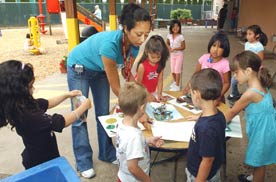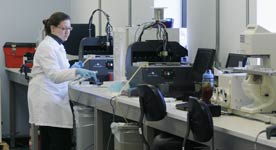
Teacher Margarita Hernandez leads a group of preschoolers in an outdoor art project at a Head Start program in Hillsboro, Oregon.
The start of a new administration will be an opportunity to focus on educational beginnings for schoolchildren across the United States. One of the greatest contributions that the new president could make to education would be to put the federal government squarely behind initiatives recognizing that improvements in schools depend on more children getting off to a good start.
The continuum that begins with preschool and extends through the end of the third grade is a crucial period that goes a long way toward determining which students will succeed. Americans should regard this as a self-contained period of learning during which each child constructs a foundation for all that follows. The end of third grade is roughly the point at which learning to read metamorphoses into reading to learn. Students unable to make this transition are more often than not destined to fall farther and farther behind with each passing year.
Financially, the federal government is a small player in education, providing less than 10 percent of the $500 billion spent annually on public elementary and secondary education. But the ways in which Washington directs that money can affect practices in the nation’s 16,000 school districts. Moreover, the federal government can exert an influence that extends far beyond its fiscal contribution, as the controversial No Child Left Behind Act (NCLB) has shown.
An approach to education called PK-3, which the Foundation for Child Development in New York City has promoted since early in this decade, calls for schools to place unprecedented emphasis on the years from preschool through the end of third grade. A growing amount of research shows that students who benefit from such an arrangement have less need for special education, can build a better foundation for reading and math, and hone social skills crucial to success in school.
Clouds hover over the future of NCLB, which was expected to be a signature achievement of President George W. Bush, but whether the program is scrapped or continued, a new president can address one of its key weaknesses by embracing PK-3. NCLB mandates the testing of students beginning in third grade, but pays insufficient attention to what happens before that point.
A president who stresses the foundational years would signal to the nation that proper preparation is essential to lifting scholastic outcomes for all children and especially for those in greatest need. What counts most is not assessing students, but doing all that is possible to ensure that more of them become fluent and confident readers by the time they enter fourth grade.
Such a step would lessen the need for students to repeat grades and, ultimately, reduce dropout figures more than almost anything else that schools might do. During 2004 and 2005, I visited classrooms in a dozen states, seeking to identify promising practices affecting students in the early grades. In the book that grew out of this research, Building Blocks: Making Children Successful in the Early Years, I zeroed in on some of the best programs that I found.
Ideally, the PK-3 progression begins with preschool for 3- and 4-year-olds. State governments are now spending $3.7 billion on preschool education. The new president should augment the state effort by expanding Early Head Start and Head Start, programs that are under the auspices of the U.S Department of Health and Human Services (HHS). The two programs serve almost a million children, but still do not have enough spaces for all eligible children.
Moreover, the president could prod HHS to make it easier for localities to blend Head Start with state-sponsored preschools, as has happened in such places as Montgomery County, Maryland, and Harrisburg, Pennsylvania.
The next step in the continuum ought to be full-day kindergarten, which is not universally available in the United States. The new president should use his bully pulpit to urge all states and school districts to close the remaining gaps that deny all too many children the opportunity to attend full-day kindergarten.
Schools should follow through by becoming more primary-minded and ensuring that education in first, second, and third grades flows directly out of prekindergarten and kindergarten experiences. The federal government is not without influence in this regard.
The $1-billion-a-year Reading First program that operated in conjunction with NCLB has been somewhat discredited, and in June 2008 congressional committees decided to end Reading First after 2009. The new president could retool the program, focusing it almost exclusively on the PK-3 continuum, and eliminating the mismanagement and conflicts of interest that brought it into disrepute.
These actions, taken together, would mark a new beginning for America’s public school children.





Comments